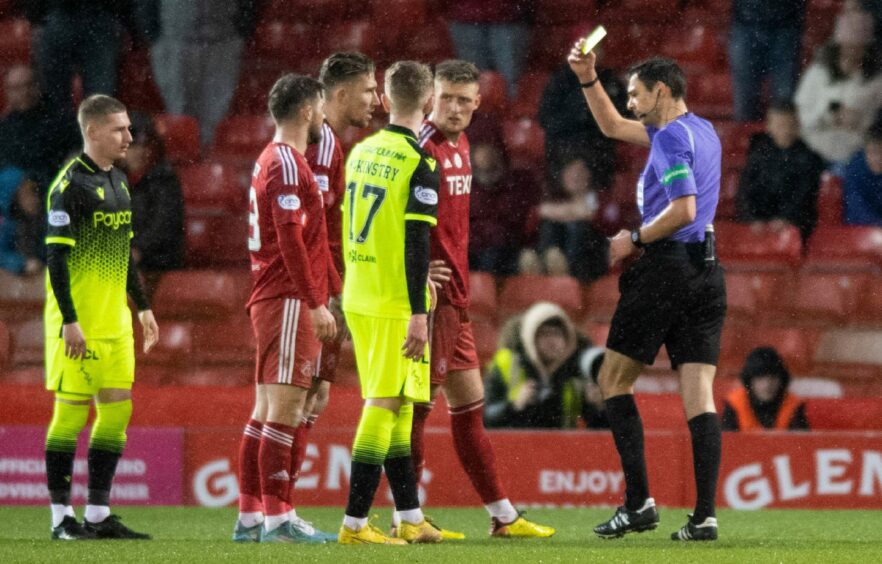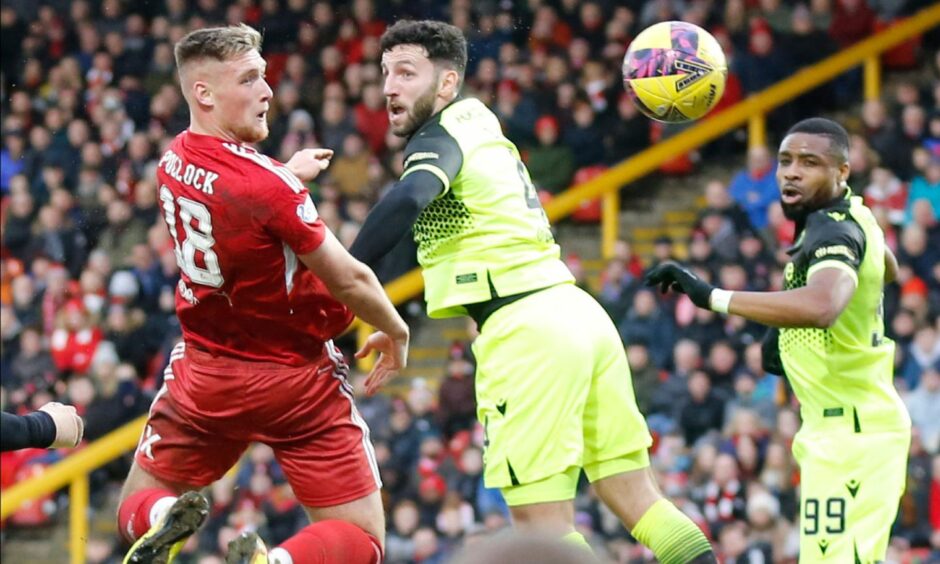Aberdeen ran out 3-1 winners when Motherwell visited in the Premiership on Saturday. But – in wake of midweek controversy against St Mirren – how did the refereeing team for the fixture perform?
Our officiating expert Finlay Elder gives his verdict following the Dons’ vital victory against the visiting Steelmen:
Why Goss elbow was a yellow, and McCrorie’s v St Mirren was a red
The first incident worth discussing from Aberdeen’s win over Motherwell was a flying elbow on Reds midfielder Ylber Ramadani from Sean Goss.
Referee Kevin Clancy showed Goss a yellow card for the action, and I think it was just about the right decision.
Here’s why –
If Goss had been challenging with a straight arm, then I could see the argument for a red.
I think it was a poor challenge, but one where Goss was fully focused on challenging for the ball – which is why he fouled Ramadani with a flailing arm.
The difference between this incident and the red card Ross McCrorie received against St Mirren is there was no extension of the arm (and elbow) into the face of the opposition player – which is what Wednesday whistler Grant Irvine deemed McCrorie guilty of, in a ruling backed up by an SFA appeals panel before the Motherwell meeting.
VAR showed usefulness with correct penalty ruling against Kennedy
We now move on to the first proper VAR involvement in the game.
With the Dons 3-0 up, Motherwell would be awarded a penalty for handball against Matty Kennedy, and my initial reaction was that a penalty was the right call.
Any time a player stretches out their arm as far as utility man Kennedy did, it is considered an unnatural position, and the ball hit a part of his arm below the sleeve line.
VAR showed its usefulness here in allowing ref Clancy to have a proper look (although these reviews are still taking far too long from a fan experience perspective) and make a ruling based on several viewings, rather than just the one quick real-time look.
Pollock goal should’ve stood, as VAR process also reminds us of frustrating flaws
Finally, we move on to the biggest controversy from Saturday – Aberdeen’s Watford loanee Mattie Pollock and his disallowed maiden Dons goal.
There are two issues here.
Firstly, I feel the goal to make it 4-1 to the home side should’ve stood.
Well’s Paul McGinn had a hold of the shirt of attacking player Pollock, while Pollock was grabbing the defender’s arm.
As such, they were both fouling each other, and I think the correct decision would have been to let the goal stand.
You can’t punish one foul and not the other, and Aberdeen certainly shouldn’t have been the team penalised because they were the team who scored.
My second point is this – Kevin Clancy was quick to award the foul, but I would have been interested to see whether the officials operating the VAR asked him to go to the monitor for another look if he hadn’t.
VAR backed the on-field decision, clearly deeming Clancy had not made a “clear and obvious” error in penalising Pollock and chalking the late Aberdeen goal off. Would they have backed it if he had ruled the other way?
I do think there is somewhat of a grey area with VAR where pretty significant decisions which could go either way are not being viewed a second time by the on-field referee, and instead everyone on the pitch is standing around for a few minutes waiting for the VAR officials, miles away from the stadium, to make up their mind.
If VAR need such a frustratingly long time to decide, surely it means it’s a contentious/borderline call, and wouldn’t it be quicker/more appropriate for the referee at the ground to just go straight over and watch the incident once or twice more, making up their own mind to stick with their decision or change it, rather than waiting ages for VAR to tell them they need to?
- Finlay Elder has been a registered referee for six years and a category 5 official since 2019, with experience in the Highland League, juniors and Club Academy.



Conversation